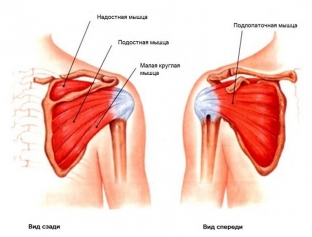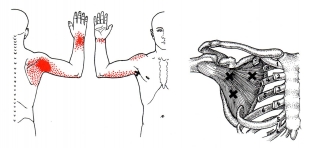The so-called frozen shoulder syndrome, which is accompanied by pain and limited mobility in the shoulder joint, can be the result of various injuries and disorders. Often this problem occurs against the background of overstrain of the subscapularis muscle. That is why in this article estet-portal.com will tell you how to localize the trigger points of the subscapularis muscle, what symptoms are typical for their appearance, as well as ways to eliminate pain caused by muscle strain.
Subscapularis: location and main functions
The very name of the subscapularis muscle (m. subscapularis) indicates its location – The muscle is located under the shoulder blade, between the chest and the shoulder blade. The muscle passes laterally and is attached to the anterior part of the humeral head of the shoulder joint.
During the contraction of the subscapularis muscle, the arm is turned inward and brought to the body. As one of the rotators of the shoulder, the subscapularis holds the shoulder joint during its movement, especially if the humeral head tends to slide upward during abduction.

Below we will look at:
- subscapularis trigger points and referred pain patterns;
- causes of subscapularis trigger points;
- subscapularis trigger point symptoms;
- Self-massage of the subscapularis to relieve pain.
As one of the rotator muscles of the shoulder, the subscapularis holds the shoulder joint during its movement.
Subscapularis trigger points and referred pain patterns
The subscapularis muscle can become the site of up to three trigger points, two of which usually appear near the outer edge of the muscle. Fortunately, the trigger point on the inner edge of the muscle is much less common, since it is almost impossible to palpate and remove it manually.

Referred pain caused by subscapularis trigger points is concentrated in the back of the shoulder, extending to the shoulder blade, down the back and upper arm. A unique pattern of referred pain around the wrist – also a common occurrence. As a rule, patients with pain around the wrist and do not realize that their cause is the subscapularis muscle.
Referred pain from subscapularis trigger points is concentrated at the back of the shoulder, radiating to the shoulder blade, down the back and upper arm.
The main causes of trigger points of the subscapularis
Trigger point activation is usually the result of muscle overload. In the case of the subscapularis, this is:
- attempting to grab onto a railing or other object while falling;
- playing baseball, tennis, swimming;
- long periods of immobilization of the arm, such as when wearing a cast due to a fracture;
- Sleep on your side with your arm under your body and your shoulder down.
Another common cause of subscapularis trigger points is bad posture, namely slouching.
The main symptoms that accompany the presence of trigger points in the subscapularis
Trigger point activity in the subscapularis muscle can lead to the following symptoms and complaints:
- severe pain in the back of the shoulder, which may appear during movement or immobility of the shoulder and be localized quite deeply;
- inability to raise arm more than 45 degrees – when you try to raise your arm to the side, there is severe pain;
- pain increases when trying to touch the armpit located under the other arm;
- frozen shoulder syndrome, or adhesive capsulitis: pain in the shoulder area, limited mobility in the shoulder joint.
Pain in the shoulder, under the shoulder blade, in the upper arm and around the wrist – possible symptoms of subscapularis overstretching.
A short guide to self-massage of the subscapularis
In order to massage the subscapularis, it must first be localized. To do this, sit in a chair or lean forward, put one arm down and relax it so that it "dangles" freely.
Place your other hand in the armpit and begin to rotate your shoulder inwards – during this movement you will feel the subscapularis muscle. Remember that this area is very sensitive because it contains a large number of nerves. Feel how the muscle contracts, then relax it and start the massage.
Make sure you only massage the muscle and do not touch the nerves, as this can lead to pain in the armpit. Massage the subscapularis muscle with your thumb, slowly running it over the sensitive points of the muscle.
Another massage option is the pressure movement: press with your right hand on the muscle located on the left side, and then perform various movements with your left hand (lift, rotate with it).
Read also: What are you really pulling: muscle stretching in pictures
As usual, estet-portal.com reminds you that wrong posture – one of the most common causes of muscle imbalance and pain caused by muscle strain. Therefore, try to monitor the position of your body throughout the day.
You may also be interested in the video:






Add a comment